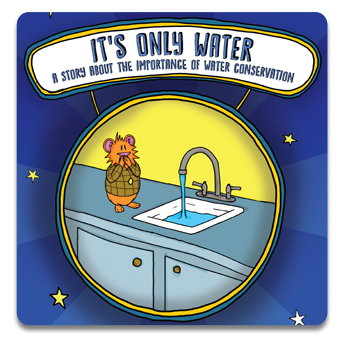Turning on a faucet and getting clean, treated water seems like a mundane activity. Most people in the U.S. and other first world countries take for granted how much effort and skill is required to produce drinking water. But without treated water, there is no coffee, showers, laundry, or toilets as we know them.
National Water Quality Month in August reminds us that it takes much more than just turning on the tap to guarantee clean, potable water. It seems only appropriate to feature the Fuddlebrook story, It’s Only Water, where Mrs. Wigglebum’s students and Herman Tweed learn the importance of water and water conservation. Read the story and watch our video of Bert’s Clean Water Filter.
The average person uses approximately 80 gallons of water or more per day. The water we use includes bathing, cleaning, household waste, and drinking water. Depending on where we live, the amount of water, usage, and treatment facilities available vary. Around the world, these variables change greatly. In some villages, drinkable water is scarce and indoor plumbing does not exist. In fact, in just one day, it is estimated that more than 152 million hours of women and girl’s time is spent collecting water for domestic use.
Those who are fortunate enough to be able to get clean water from our tap as often as we like take it for granted. But those who have to work so hard to get to village wells (if even that) know how important water is to every aspect of life. People cannot survive without clean water, and neither can ecosystems. Water is crucial for the survival of humans and the planet.
It goes far beyond mere drinking water. Water “is vital for reducing the global burden of disease and improving the health, welfare, and productivity of populations,” according to the UN.
Here are some statistics:
What can we do? Reducing pollution, eliminating dumping, minimizing the release of hazardous chemicals and materials, and increasing recycling are important. Increasing water-use efficiency is key, too. Estimates vary, but each person uses about 80-100 gallons of water per day. Are you surprised that the largest use of household water is to flush the toilet, and after that, to take showers and baths? Simply reducing shower time or turning off the faucet while brushing our teeth or shaving makes a big difference!
But that’s not all. Protecting and restoring water-related ecosystems, including mountains, forests, wetlands, rivers, aquifers, and lakes are vitally important as well. Check out this month’s video on our Quirkles site, Underwater Utley’s Oil Spill Investigation to learn some sobering facts about the impact of oil spills on marine life.
Ultimately, ensuring clean water takes the collaboration of governments, businesses, communities, and individuals. Now more than ever, water is an issue we should all care about!
